

The starting point is a system without time or space, which is described as a sort of preexisting primeval body of water. It is destroyed when four dichotomies develop within it of their own impetus; these are to be understood as its multiple characteristics. The four pairs, which are designated as the Ogdoad (“the Eight”) are named:
![]() Nun and Naunet: Immobility
Nun and Naunet: Immobility
![]() Heh and Hehet: Eternity
Heh and Hehet: Eternity
![]() Kek and Keket: Darkness
Kek and Keket: Darkness
![]() Tenemu and Tenemuit: Lack of direction
Tenemu and Tenemuit: Lack of direction
The last pair can be replaced by:
![]() Amun and Amaunet: Concealment
Amun and Amaunet: Concealment
![]() Niau and Niaut: Emptiness
Niau and Niaut: Emptiness
![]() Gereh and Gerehet: Absence
Gereh and Gerehet: Absence
Although these pairs are essentially intangible qualities, their division into four masculine and four feminine components becomes the first criterion for organization. The number “four” stands for the four cardinal directions (as we say, the four corners of the Earth) and is therefore connected with the concept of space. These principles of organization break up the original system and pave the way for a phase of transition, in which both aspects, the sexuality of living beings and the demarcation of space, are established.
The earliest female beings are represented as snakes or snake-headed women, and the earliest males are imagined as frogs or frog-headed men (Fig. 6).
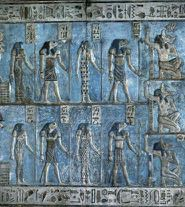
The formation of the Ogdoad (“the Eight”) sets into motion a process through which matter is created. In most of the myths, this process is connected to the concept of an original hill or monolith (the so-called “Benben Stone”), rising up out of the primeval waters. This concept was based on the observation of the retreating Nile waters at the end of the annual flood season, when the hills start to appear again, one by one, above the surface of the water.
On the primeval hill, the creator god first takes on a form such as Atum or Amun-Ra. His most important manifestation is as the sun god who, in one version, as a benu bird (water wagtail or heron) sets down on the primeval hill or rises up out of a primeval egg. This original egg swims either all by itself in the primeval body of water or is carried up to the primeval hill by a spirit in bird form (such as by the Ibis of the god Thoth) or is laid there by a Nile goose (the so- called “Great Gabbler”). The sounds of the original bird break through the silence for the first time, and the sun god drives out the darkness with his light. The original flood (such as occurs in connection with the goddess Neith) and the original hill (for example, Tatenen) can also be personified and possess their own power of procreation.
In another version, instead of the primeval hill, an Egyptian lotus blossom (as, for instance, with the god Nefertem) surfaces above the primeval ocean (Fig. 7) and brings it the first light, as well as the first pleasant scent.
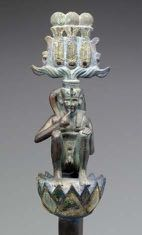
The various creation myths name not only different gods but also different ways of coming into being. In Heliopolis, the god Atum (Fig. 8) is the Creator, from whose emanations (that is, matter exuding out of him) the universe and forms of life come into being.
In Memphis, Ptah (Fig. 9) creates the world through his intellect and his word; in Esna and on the island of Elephantine, it is Khnum who sculpts living beings on a potter’s wheel.
The Theban gods Month and Amun (Fig. 10) acquire their creative powers by connecting themselves to the Hermopolitan and Heliopolitan systems; in this way, both gods band with the primeval deities of “the Eight”, as well as with Atum and Ra, to one entity (Fig. 10).
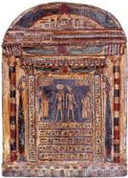
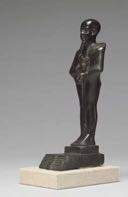
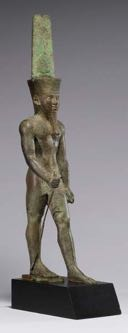
During the Amarna Period under King Akhenaton, the god Aton (Fig. 11) becomes a universal god and father of Ra and thus also a creator god. The process of creation here is not described any closer, though, only the function of Aton as the universal god. Female creator deities are known, as well — for instance, the aforementioned Neith of Sais (Fig. 12), who is involved with the flooding of the Nile and can be understood as the founder of “the Eight.”
In some contexts (such as the Books of the Underworld), the creative forces are named more specifically and personified. Among those named are Heka (“magical creative force”), Sia (“knowledge”) and Hu (“the powerful word”).
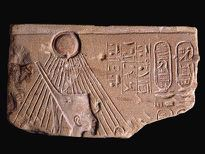

The different theological concepts were not regarded as contradictory but as an assortment of means of communicating of similar ideas. Atum-Ra does not replace Ptah, but the two can form a trinity (and therefore a unit) together with the concept of the god of the primeval hill, Tatenen, who was the first to rise up out of the primeval waters of preexistence. The multifaceted concept of “god” can expressitself in the various aspects of one particular god or in a large number of gods. The ancient Egyptian was less inclined to ask the question, “Who is the creator god?” but rather, “What is his nature?” The answer to this question is clear in all Egyptian models, however they may differ otherwise: “He is the one who has created everything that exists” and the one who has brought himself into being.
He is the unique being that creates or allows the transition from an unknown, amorphous, preexisting phase to a conscious existence and a new system. The name of Atum also points to this function, since it can mean “Nothingness” as well as “All” [⇒5].
| |
|
Regine C. Schulz: |
|
Contents
Presentation |